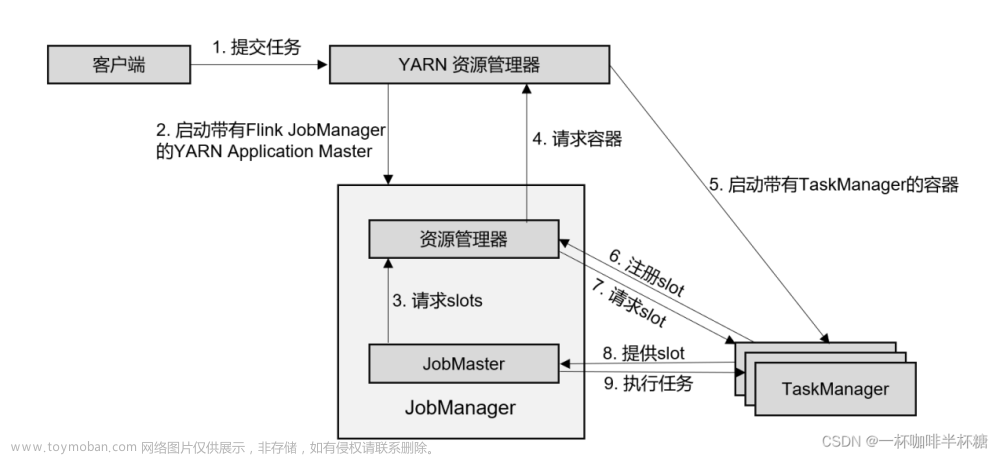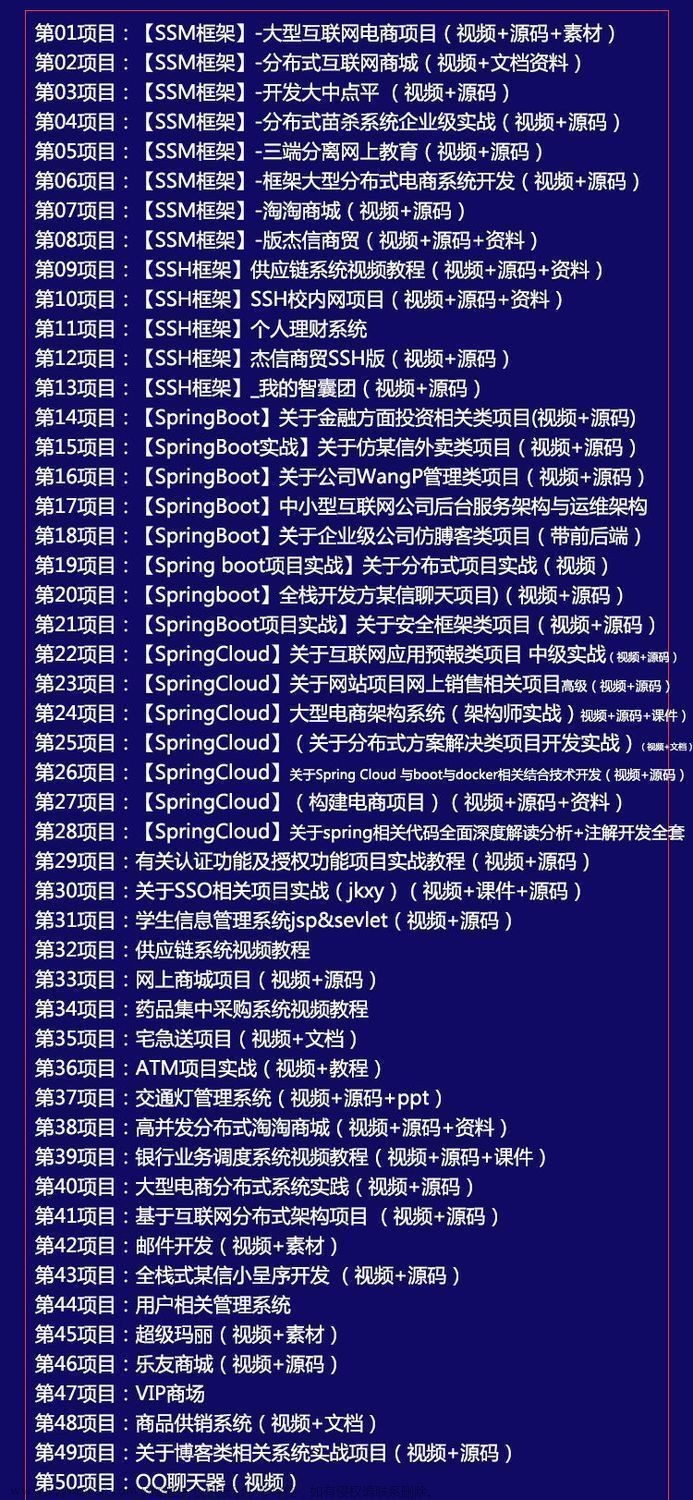启动一个任务
通常我们会使用 bin/flink run -t yarn-per-job -c com.xxx.xxx.WordCount/WordCount.jar 方式启动任务;我们看一下 flink文件中到底做了什么,以下是其部分源码
# Convert relative path to absolute path
bin=`dirname "$target"`
# get flink config
. "$bin"/config.sh
if [ "$FLINK_IDENT_STRING" = "" ]; then
FLINK_IDENT_STRING="$USER"
fi
CC_CLASSPATH=`constructFlinkClassPath`
log=$FLINK_LOG_DIR/flink-$FLINK_IDENT_STRING-client-$HOSTNAME.log
log_setting=(-Dlog.file="$log" -Dlog4j.configuration=file:"$FLINK_CONF_DIR"/log4j-cli.properties -Dlog4j.configurationFile=file:"$FLINK_CONF_DIR"/log4j-cli.properties -Dlogback.configurationFile=file:"$FLINK_CONF_DIR"/logback.xml)
# Add Client-specific JVM options
FLINK_ENV_JAVA_OPTS="${FLINK_ENV_JAVA_OPTS} ${FLINK_ENV_JAVA_OPTS_CLI}"
# Add HADOOP_CLASSPATH to allow the usage of Hadoop file systems
exec "${JAVA_RUN}" $JVM_ARGS $FLINK_ENV_JAVA_OPTS "${log_setting[@]}" -classpath "`manglePathList "$CC_CLASSPATH:$INTERNAL_HADOOP_CLASSPATHS"`" org.apache.flink.client.cli.CliFrontend "$@"
可以看到,第一步将相对地址转换成绝对地址;第二步获取 Flink 配置信息,这个信息放在 bin 目录下的 config. sh中;第三步获取 JVM 配置信息;最后一步就是程序真正的入口 org.apache.flink.client.cli.CliFrontend,这里有几点需要注意的:
- Linux-
exec命令用于调用并执行指令; - 在配置文件中
JAVA_RUN="$JAVA_HOME"/bin/java,因此这里运行的是 Java 程序; -
FLINK_ENV_JAVA_OPTS:是上文获取的关于 JVM 的相关配置; -
java -cp和 -classpath 一样,是指定类运行所依赖其他类的路径; -
INTERNAL_HADOOP_CLASSPATHS="${HADOOP_CLASSPATH}:${HADOOP_CONF_DIR}:${YARN_CONF_DIR}":config. sh文件指定了 Hadoop 的相关路径; -
"$@"表示所有参数以以"$1" " $2" … "$ n"的形式输出,例如bin/flink run -t yarn-per-job -c com.xxx.xxx.WordCount/WordCount.jar -p 11 "$@"会解析成run -t yarn-per-job -c com.xxx.xxx.WordCount/WordCount.jar -p 11。
小结一下,我们任务的提交流程是输入启动命令→读取配置信息→ java -cp 开启虚拟机→开启 CliFrontend→运行 CliFrontend. run
CliFrontend 详解
class CliFrontend{
protected void run(String[] args) throws Exception {
LOG.info("Running 'run' command.");
// TODO 获取默认的运行时参数
final Options commandOptions = CliFrontendParser.getRunCommandOptions();
// 解析参数返回CommandLine对象
// 解析见-> DefaultParser详解,核心逻辑是使用CliFrontendParser进行解析->使用DefaultParser进行解析
final CommandLine commandLine = getCommandLine(commandOptions, args, true);
// evaluate help flag
if (commandLine.hasOption(HELP_OPTION.getOpt())) {
CliFrontendParser.printHelpForRun(customCommandLines);
return;
}
// TODO 按照Generic、Yarn、Default顺序判断是否活跃
// 详解见 -> sub1
final CustomCommandLine activeCommandLine =
validateAndGetActiveCommandLine(checkNotNull(commandLine));
// TODO 根据输入参数封装了一个ProgramOptions
// 详解见 -> ProgramOptions
final ProgramOptions programOptions = ProgramOptions.create(commandLine);
// TODO 获取任务Jar包和依赖项;
// 详解见 -> sub2
final List<URL> jobJars = getJobJarAndDependencies(programOptions);
// TODO 获取有效配置 -> 这里的逻辑最终是调用每一个CLI的toConfiguration方法
final Configuration effectiveConfiguration =
getEffectiveConfiguration(activeCommandLine, commandLine, programOptions, jobJars);
// TODO 打印日志信息,
LOG.debug("Effective executor configuration: {}", effectiveConfiguration);
// TODO 将programOptions(程序)和effectiveConfiguration(有效配置信息)再封装成一个PackagedProgram对象
try (PackagedProgram program = getPackagedProgram(programOptions, effectiveConfiguration)) {
// TODO 执行封装对象
executeProgram(effectiveConfiguration, program);
}
}
// ****************************** sub1 ******************************************** //
public CustomCommandLine validateAndGetActiveCommandLine(CommandLine commandLine) {
LOG.debug("Custom commandlines: {}", customCommandLines);
for (CustomCommandLine cli : customCommandLines) {
LOG.debug(
"Checking custom commandline {}, isActive: {}", cli, cli.isActive(commandLine));
// 按照Generic、Yarn、Default顺序判断是否活跃,具体分析见下文
if (cli.isActive(commandLine)) {
return cli;
}
}
throw new IllegalStateException("No valid command-line found.");
}
// ************************************************************************** //
// ****************************** sub2 ******************************************** //
private List<URL> getJobJarAndDependencies(ProgramOptions programOptions)
throws CliArgsException {
// TODO 获取入口类
String entryPointClass = programOptions.getEntryPointClassName();
// TODO 获取JAR包路径
String jarFilePath = programOptions.getJarFilePath();
try {
File jarFile = jarFilePath != null ? getJarFile(jarFilePath) : null;
return PackagedProgram.getJobJarAndDependencies(jarFile, entryPointClass);
} catch (FileNotFoundException | ProgramInvocationException e) {
throw new CliArgsException(
"Could not get job jar and dependencies from JAR file: " + e.getMessage(), e);
}
}
// ************************************************************************** //
}
c
class DefaultParser{
}
/*
CustomCommandLine 是一个接口,GenericCLI、AbstractYarnCli、DefaultCLI
继承关系见下图
*/
class GenericCLI {
/* 每一个Option都是这样的解析逻辑,有一个短的opt参数进行判断,同时有一个longOpt参数进行辅助判断,
以executorOption为例,就是命令行中有-e 或者 -executor 就会返回True
*/
private final Option executorOption =
new Option(
"e",
"executor",
true,
"DEPRECATED: Please use the -t option instead which is also available with the \"Application Mode\".\n"
+ "The name of the executor to be used for executing the given job, which is equivalent "
+ "to the \""
+ DeploymentOptions.TARGET.key()
+ "\" config option. The "
+ "currently available executors are: "
+ getExecutorFactoryNames()
+ ".");
/*
1. 获取验证配置项是否存在
2. 获取验证执行器参数,即-e, executor
3. 获取验证目标参数是否存在,即-t target
*/
public boolean isActive(CommandLine commandLine) {
// configuration是配置文件
return configuration.getOptional(DeploymentOptions.TARGET).isPresent()
|| commandLine.hasOption(executorOption.getOpt())
|| commandLine.hasOption(targetOption.getOpt());
}
}
class FlinkYarnSessionCli{
public boolean isActive(CommandLine commandLine) {
// 调用父类的的isActive方法
if (!super.isActive(commandLine)) {
return (isYarnPropertiesFileMode(commandLine)
&& yarnApplicationIdFromYarnProperties != null);
}
return true;
}
public Configuration toConfiguration(CommandLine commandLine) throws FlinkException {
// we ignore the addressOption because it can only contain "yarn-cluster"
final Configuration effectiveConfiguration = new Configuration();
applyDescriptorOptionToConfig(commandLine, effectiveConfiguration);
// TODO 获取APPID,查看是否启动了集群
final ApplicationId applicationId = getApplicationId(commandLine);
if (applicationId != null) {
final String zooKeeperNamespace;
if (commandLine.hasOption(zookeeperNamespace.getOpt())) {
zooKeeperNamespace = commandLine.getOptionValue(zookeeperNamespace.getOpt());
} else {
zooKeeperNamespace =
effectiveConfiguration.getString(HA_CLUSTER_ID, applicationId.toString());
}
// TODO 设置高可用
effectiveConfiguration.setString(HA_CLUSTER_ID, zooKeeperNamespace);
// TODO 设置YARN的应用ID
effectiveConfiguration.setString(
YarnConfigOptions.APPLICATION_ID, applicationId.toString());
// 执行器,已经启动了集群就是Session模式
effectiveConfiguration.setString(
DeploymentOptions.TARGET, YarnSessionClusterExecutor.NAME);
} else {
// 没启动集群就是per-JOB 模式
effectiveConfiguration.setString(DeploymentOptions.TARGET, YarnJobClusterExecutor.NAME);
}
// TODO 如果有JM内存设置,则进行设置
if (commandLine.hasOption(jmMemory.getOpt())) {
String jmMemoryVal = commandLine.getOptionValue(jmMemory.getOpt());
if (!MemorySize.MemoryUnit.hasUnit(jmMemoryVal)) {
jmMemoryVal += "m";
}
// TODO 添加JM内存设置
effectiveConfiguration.set(
JobManagerOptions.TOTAL_PROCESS_MEMORY, MemorySize.parse(jmMemoryVal));
}
// TODO 如果有TM总内存设置,则进行设置
if (commandLine.hasOption(tmMemory.getOpt())) {
String tmMemoryVal = commandLine.getOptionValue(tmMemory.getOpt());
if (!MemorySize.MemoryUnit.hasUnit(tmMemoryVal)) {
tmMemoryVal += "m";
}
// TODO 添加TM的总内存;
effectiveConfiguration.set(
TaskManagerOptions.TOTAL_PROCESS_MEMORY, MemorySize.parse(tmMemoryVal));
}
// TODO 如果有SLOT数设置,则进行设置
if (commandLine.hasOption(slots.getOpt())) {
// 每个TM的SLOT数
effectiveConfiguration.setInteger(
TaskManagerOptions.NUM_TASK_SLOTS,
Integer.parseInt(commandLine.getOptionValue(slots.getOpt())));
}
// TODO 设置动态属性
dynamicPropertiesEncoded = encodeDynamicProperties(commandLine);
if (!dynamicPropertiesEncoded.isEmpty()) {
Map<String, String> dynProperties = getDynamicProperties(dynamicPropertiesEncoded);
for (Map.Entry<String, String> dynProperty : dynProperties.entrySet()) {
effectiveConfiguration.setString(dynProperty.getKey(), dynProperty.getValue());
}
}
if (isYarnPropertiesFileMode(commandLine)) {
return applyYarnProperties(effectiveConfiguration);
} else {
return effectiveConfiguration;
}
}
}
// FlinkYarnSessionCli的父类
class AbstractYarnCli{
public boolean isActive(CommandLine commandLine) {
// TODO 获取JM地址
final String jobManagerOption = commandLine.getOptionValue(addressOption.getOpt(), null);
// TODO ID = “yarn-cluster”,
final boolean yarnJobManager = ID.equals(jobManagerOption);
// TODO 如果Yarn启动,则会有APPID,判断是否有APPID;1. 看输入命令中是否有APPID;2.从配置文件中读取APPID;
final boolean hasYarnAppId =
commandLine.hasOption(applicationId.getOpt())
|| configuration.getOptional(YarnConfigOptions.APPLICATION_ID).isPresent();
// TODO 使用“yarn-session”或者“yarn-per-job”进行比较
final boolean hasYarnExecutor =
YarnSessionClusterExecutor.NAME.equalsIgnoreCase(
configuration.get(DeploymentOptions.TARGET))
|| YarnJobClusterExecutor.NAME.equalsIgnoreCase(
configuration.get(DeploymentOptions.TARGET));
// -m yarn-cluster || yarn 有APPID、命令行制定了 || 执行器是YARN的
return hasYarnExecutor || yarnJobManager || hasYarnAppId;
}
}
// DefaultCLI用来部署Standalone模式
class DefaultCLI{
public boolean isActive(CommandLine commandLine) {
// 永远返回True
return true;
}
}
class ProgramOptions {
public static ProgramOptions create(CommandLine line) throws CliArgsException {
if (isPythonEntryPoint(line) || containsPythonDependencyOptions(line)) {
// Python相关的类都是调用这个方法
return createPythonProgramOptions(line);
} else {
// 其他都是调用这个方法
return new ProgramOptions(line);
}
}
protected ProgramOptions(CommandLine line) throws CliArgsException {
super(line);
// TODO 获取入口类
this.entryPointClass =
line.hasOption(CLASS_OPTION.getOpt())
? line.getOptionValue(CLASS_OPTION.getOpt())
: null;
// TODO 获取JAR包
this.jarFilePath =
line.hasOption(JAR_OPTION.getOpt())
? line.getOptionValue(JAR_OPTION.getOpt())
: null;
this.programArgs = extractProgramArgs(line);
// TODO 路径解析并添加到一个ArrayList中
List<URL> classpaths = new ArrayList<URL>();
if (line.hasOption(CLASSPATH_OPTION.getOpt())) {
for (String path : line.getOptionValues(CLASSPATH_OPTION.getOpt())) {
try {
classpaths.add(new URL(path));
} catch (MalformedURLException e) {
throw new CliArgsException("Bad syntax for classpath: " + path);
}
}
}
this.classpaths = classpaths;
// TODO 先检查是否有并行度设置,如果有则解析并行度并进行值检查,如果没有则使用默认并行度
if (line.hasOption(PARALLELISM_OPTION.getOpt())) {
String parString = line.getOptionValue(PARALLELISM_OPTION.getOpt());
try {
parallelism = Integer.parseInt(parString);
if (parallelism <= 0) {
throw new NumberFormatException();
}
} catch (NumberFormatException e) {
throw new CliArgsException(
"The parallelism must be a positive number: " + parString);
}
} else {
parallelism = ExecutionConfig.PARALLELISM_DEFAULT;
}
// TODO 分发模式,这个和上文介绍的executorOption判断逻辑是一致的。
detachedMode =
line.hasOption(DETACHED_OPTION.getOpt())
|| line.hasOption(YARN_DETACHED_OPTION.getOpt());
shutdownOnAttachedExit = line.hasOption(SHUTDOWN_IF_ATTACHED_OPTION.getOpt());
this.savepointSettings = CliFrontendParser.createSavepointRestoreSettings(line);
}
}
class JobManagerOptions{
public static final ConfigOption<MemorySize> TOTAL_PROCESS_MEMORY =
// 这类配置信息都是这种链式调用
key("jobmanager.memory.process.size")
.memoryType()
.noDefaultValue()
.withDescription(
"Total Process Memory size for the JobManager. This includes all the memory that a "
+ "JobManager JVM process consumes, consisting of Total Flink Memory, JVM Metaspace, and JVM Overhead. "
+ "In containerized setups, this should be set to the container memory. See also "
+ "'jobmanager.memory.flink.size' for Total Flink Memory size configuration.");
}
CustomCommandLine 继承关系:文章来源:https://www.toymoban.com/news/detail-632359.html
 文章来源地址https://www.toymoban.com/news/detail-632359.html
文章来源地址https://www.toymoban.com/news/detail-632359.html
参数解析
class CliFrontendParser{
// 选项列表
// 解析和以executorOption等的逻辑都是一样的
static final Option SAVEPOINT_DISPOSE_OPTION =
new Option("d", "dispose", true, "Path of savepoint to dispose.");
static final Option HELP_OPTION =
new Option(
"h",
"help",
false,
"Show the help message for the CLI Frontend or the action.");
...
}
class DefaultParser{
public CommandLine parse(Options options, String[] arguments, Properties properties, boolean stopAtNonOption) throws ParseException {
...;
if (arguments != null) {
String[] var9 = arguments;
int var10 = arguments.length;
for(int var7 = 0; var7 < var10; ++var7) {
String argument = var9[var7];
// 核心解析逻辑
this.handleToken(argument);
}
}
...
}
private void handleToken(String token) throws ParseException {
this.currentToken = token;
if (this.skipParsing) {
this.cmd.addArg(token);
} else if ("--".equals(token)) {
this.skipParsing = true;
} else if (this.currentOption != null && this.currentOption.acceptsArg() && this.isArgument(token)) {
// 添加参数值
this.currentOption.addValueForProcessing(
this.stripLeadingAndTrailingQuotesDefaultOn(token));
} else if (token.startsWith("--")) {
// TODO 解析 -- 形式参数;
this.handleLongOption(token);
} else if (token.startsWith("-") && !"-".equals(token)) {
// TODO 解析 - 形式参数
this.handleShortAndLongOption(token);
} else {
// TODO 解析未知参数
this.handleUnknownToken(token);
}
if (this.currentOption != null && !this.currentOption.acceptsArg()) {
this.currentOption = null;
}
}
private void handleLongOption(String token) throws ParseException {
if (token.indexOf(61) == -1) {
// TODO 解析的是不包含=号的,例如-L、--l
this.handleLongOptionWithoutEqual(token);
} else {
// TODO 解析包含=号的,例如--L=V
this.handleLongOptionWithEqual(token);
}
}
// 解析逻辑都是去除前缀,然后校验参数
private void handleLongOptionWithoutEqual(String token) throws ParseException {
List<String> matchingOpts = this.getMatchingLongOptions(token);
if (matchingOpts.isEmpty()) {
this.handleUnknownToken(this.currentToken);
} else {
if (matchingOpts.size() > 1 && !this.options.hasLongOption(token)) {
throw new AmbiguousOptionException(token, matchingOpts);
}
String key = this.options.hasLongOption(token) ? token : (String)matchingOpts.get(0);
// 参数添加到执行命令
this.handleOption(this.options.getOption(key));
}
}
private List<String> getMatchingLongOptions(String token) {
if (this.allowPartialMatching) {
// 部分匹配走这里
return this.options.getMatchingOptions(token);
} else {
List<String> matches = new ArrayList(1);
if (this.options.hasLongOption(token)) {
// 获取参数
Option option = this.options.getOption(token);
// 添加参数
matches.add(option.getLongOpt());
}
return matches;
}
}
public Option getOption(String opt) {
// 先去前缀
opt = Util.stripLeadingHyphens(opt);
// 去完前缀后看短字符有没有包含,有返回短参数否则返回长参数
return this.shortOpts.containsKey(opt) ? (Option)this.shortOpts.get(opt) : (Option)this.longOpts.get(opt);
}
private void handleOption(Option option) throws ParseException {
// 添加前先检查起哪一个参数
this.checkRequiredArgs();
option = (Option)option.clone();
this.updateRequiredOptions(option);
// 添加参数
this.cmd.addOption(option);
// 设置当前参数,跟checkRequiredArgs 这个方法相配合
if (option.hasArg()) {
this.currentOption = option;
} else {
this.currentOption = null;
}
}
}
小结
- 程序的入口命令:
run -t yarn-per-job /opt/module...ratget.jar --port 9999 - 入口类是:org.apache.flink.client.cli.CliFrontend;环境信息:Config.sh
- 在
Run方法中-
validateAndGetActiveCommandLine:按照Generic、Yarn、Default顺序判断是否活跃,创建对应的客户端;-
Generic的
isActive方法中- 获取验证配置项是否存在
- 获取验证执行器参数是否存在,即
-e, executor - 获取验证目标参数是否存在,即
-t target
-
FlinkYarnSessionCli的
isActive方法-
-m yarn-cluster:判断是否是per-job模式; - 根据 JM 地址→是否有 APPID,看是否启动了 Yarn(从命令行和配置信息中检查)
- 使用“yarn-session”或者“yarn-per-job”进行比较,看exector是否是这两个;
- 上述三种情况任意一种成立都会使用 Yarn 模式;
-
- Default的
isActive方法永远返回True;
-
Generic的
- 根据输入参数封装了一个ProgramOptions对象,该对象包括 Java 的主要获取入口类、JAR 包路径、程序参数、并行度等;
- 获取并设置有效配置(高可用、JM 和 TM 内存、TM-SLOT 数),简而言之就是将多个配置信息(activeCommandLine, commandLine,programOptions, jobJars)变成一个Configuration对象;
- 将程序+配置信息封装成一个PackagedProgram对象然后调用其
execute方法执行任务;
-
往期回顾
- 【Flink】Flink时间语义详解
- 【Flink】详解JobGraph
- 【Flink】详解StreamGraph
- 【Flink】浅谈Flink架构和调度
- 【Flink】详解Flink的八种分区
- 【Flink】浅谈Flink背压问题(1)
- 【分布式】浅谈CAP、BASE理论(1)
到了这里,关于【Flink】详解Flink任务提交流程的文章就介绍完了。如果您还想了解更多内容,请在右上角搜索TOY模板网以前的文章或继续浏览下面的相关文章,希望大家以后多多支持TOY模板网!











